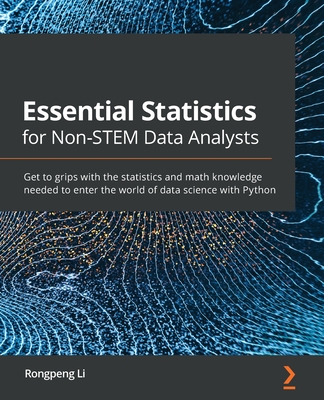A Practitioner's Guide to Resampling for Data Analysis, Data Mining, and Modeling (Hardcover)
暫譯: 數據分析、數據挖掘與建模的重抽樣實務指南 (精裝版)
Phillip Good
- 出版商: CRC
- 出版日期: 2011-08-25
- 售價: $2,880
- 貴賓價: 9.5 折 $2,736
- 語言: 英文
- 頁數: 224
- 裝訂: Hardcover
- ISBN: 1439855501
- ISBN-13: 9781439855508
-
相關分類:
Data Science、Data-mining
立即出貨 (庫存=1)
買這商品的人也買了...
-
 Linux 驅動程式, 3/e (Linux Device Drivers, 3/e)
Linux 驅動程式, 3/e (Linux Device Drivers, 3/e)$980$774 -
 深入淺出 Ajax (Head First Ajax)
深入淺出 Ajax (Head First Ajax)$680$537 -
 Excel 2007 實力養成暨評量解題秘笈
Excel 2007 實力養成暨評量解題秘笈$250$198 -
 Embedded Linux 嵌入式系統開發實務, 2/e (Embedded Linux Primer: A Practical Real-World Approach, 2/e)
Embedded Linux 嵌入式系統開發實務, 2/e (Embedded Linux Primer: A Practical Real-World Approach, 2/e)$780$616 -
 NXT 樂高機器人-創意樂趣,隨心所欲!, 2/e
NXT 樂高機器人-創意樂趣,隨心所欲!, 2/e$450$383 -
 Android 技術內幕-探索 Android 核心原理與系統開發
Android 技術內幕-探索 Android 核心原理與系統開發$580$458 -
 Linux 裝置驅動程式之開發詳解, 2/e
Linux 裝置驅動程式之開發詳解, 2/e$780$616 -
 Android 系統原理深入解析
Android 系統原理深入解析$520$442 -
 Debug Hacks 除錯駭客 -- 極致除錯的技巧與工具
Debug Hacks 除錯駭客 -- 極致除錯的技巧與工具$580$458 -
![ASP.NET 4.5 專題實務 [I]-C# 入門實戰篇-cover](https://cf-assets1.tenlong.com.tw/images/71291/medium/9789572240601_bc.jpg) ASP.NET 4.5 專題實務 [I]-C# 入門實戰篇
ASP.NET 4.5 專題實務 [I]-C# 入門實戰篇$780$616 -
 《超強圖解》前進 App Store!iOS 6 SDK 實戰演練
《超強圖解》前進 App Store!iOS 6 SDK 實戰演練$950$808 -
 強勢回歸 Microsoft Hyper-V 2012 從零開始-複本、叢集、即時移轉、高可用性 (附教學影片)
強勢回歸 Microsoft Hyper-V 2012 從零開始-複本、叢集、即時移轉、高可用性 (附教學影片)$680$544 -
 Windows Server 2012 系統建置實務
Windows Server 2012 系統建置實務$680$537 -
 iPad mini + iPad 4 使用手冊
iPad mini + iPad 4 使用手冊$399$315 -
 演算法-使用 C++ 虛擬碼, 4/e (Foundations of Algorithms, 4/e)
演算法-使用 C++ 虛擬碼, 4/e (Foundations of Algorithms, 4/e)$680$537 -
 PHP、MySQL、JavaScript 與 CSS 學習手冊, 2/e (Learning PHP, MySQL, JavaScript, and CSS: A Step-by-Step Guide to Creating Dynamic Websites, 2/e)
PHP、MySQL、JavaScript 與 CSS 學習手冊, 2/e (Learning PHP, MySQL, JavaScript, and CSS: A Step-by-Step Guide to Creating Dynamic Websites, 2/e)$880$695 -
 HTML5 完美風暴, 2/e
HTML5 完美風暴, 2/e$1,000$700 -
 ASP.NET MVC 4 網站開發美學
ASP.NET MVC 4 網站開發美學$680$537 -
 Windows Azure Platform 應用程式開發教戰手札, 2/e
Windows Azure Platform 應用程式開發教戰手札, 2/e$520$411 -
 無瑕的程式碼-敏捷軟體開發技巧守則 (Clean Code: A Handbook of Agile Software Craftsmanship)
無瑕的程式碼-敏捷軟體開發技巧守則 (Clean Code: A Handbook of Agile Software Craftsmanship)$580$452 -
 Raspberry Pi 快速上手指南 (Raspberry Pi:A Quick-Start Guide)
Raspberry Pi 快速上手指南 (Raspberry Pi:A Quick-Start Guide)$420$378 -
 超圖解 Arduino 互動設計入門 (附 Arduino UNO R3 開發板)
超圖解 Arduino 互動設計入門 (附 Arduino UNO R3 開發板)$1,130$893 -
 Android 初學特訓班, 3/e (暢銷改版,全新 Android 4.X 版 / 適用 Android 4.X~2.X,附影音教學/範例/小綠人素材)
Android 初學特訓班, 3/e (暢銷改版,全新 Android 4.X 版 / 適用 Android 4.X~2.X,附影音教學/範例/小綠人素材)$480$379 -
 CSS3 網頁設計師手札, 4/e (The CSS3 Anthology: Take Your Sites to New Heights, 4/e)
CSS3 網頁設計師手札, 4/e (The CSS3 Anthology: Take Your Sites to New Heights, 4/e)$450$356 -
 Google 教我的 101 個工作最佳化:效率第一名的數位工作實踐法
Google 教我的 101 個工作最佳化:效率第一名的數位工作實踐法$380$199
商品描述
Distribution-free resampling methods—permutation tests, decision trees, and the bootstrap—are used today in virtually every research area. A Practitioner’s Guide to Resampling for Data Analysis, Data Mining, and Modeling explains how to use the bootstrap to estimate the precision of sample-based estimates and to determine sample size, data permutations to test hypotheses, and the readily-interpreted decision tree to replace arcane regression methods.
Highlights
- Each chapter contains dozens of thought provoking questions, along with applicable R and Stata code
- Methods are illustrated with examples from agriculture, audits, bird migration, clinical trials, epidemiology, image processing, immunology, medicine, microarrays and gene selection
- Lists of commercially available software for the bootstrap, decision trees, and permutation tests are incorporated in the text
- Access to APL, MATLAB, and SC code for many of the routines is provided on the author’s website
- The text covers estimation, two-sample and k-sample univariate, and multivariate comparisons of means and variances, sample size determination, categorical data, multiple hypotheses, and model building
Statistics practitioners will find the methods described in the text easy to learn and to apply in a broad range of subject areas from A for Accounting, Agriculture, Anthropology, Aquatic science, Archaeology, Astronomy, and Atmospheric science to V for Virology and Vocational Guidance, and Z for Zoology.
Practitioners and research workers and in the biomedical, engineering and social sciences, as well as advanced students in biology, business, dentistry, medicine, psychology, public health, sociology, and statistics will find an easily-grasped guide to estimation, testing hypotheses and model building.
商品描述(中文翻譯)
分佈無關的重抽樣方法——置換檢驗、決策樹和自助法——如今幾乎在每個研究領域中都被使用。《數據分析、數據挖掘和建模的重抽樣實務指南》解釋了如何使用自助法來估計基於樣本的估計值的精確度,確定樣本大小,使用數據置換來檢驗假設,以及使用易於解釋的決策樹來取代晦澀的迴歸方法。
重點
- 每章包含數十個引人深思的問題,以及適用的 R 和 Stata 代碼
- 方法通過來自農業、審計、鳥類遷徙、臨床試驗、流行病學、影像處理、免疫學、醫學、微陣列和基因選擇的例子進行說明
- 文中包含商業可用的自助法、決策樹和置換檢驗的軟體列表
- 作者網站提供許多例程的 APL、MATLAB 和 SC 代碼
- 本文涵蓋估計、兩樣本和 k 樣本的單變量及多變量均值和方差比較、樣本大小確定、類別數據、多重假設和模型建構
統計實務工作者會發現文中描述的方法易於學習,並可應用於從會計、農業、人類學、水生科學、考古學、天文學、大氣科學等 A 到病毒學、職業指導等 V,及動物學等 Z 的廣泛主題領域。
實務工作者和研究人員,尤其是在生物醫學、工程和社會科學領域的研究人員,以及生物學、商業、牙科、醫學、心理學、公共衛生、社會學和統計學的高級學生,將會發現這是一個易於理解的估計、假設檢驗和模型建構指南。

























